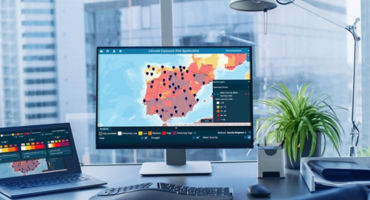- Climate Transition Risk Analyst
Skip to main content
- Funds
- Insights
- Capabilities
- About Us
- My Account
The views expressed are those of the authors at the time of writing. Other teams may hold different views and make different investment decisions. The value of your investment may become worth more or less than at the time of original investment. While any third-party data used is considered reliable, its accuracy is not guaranteed. For professional, institutional, or accredited investors only.
Climate change continues to be a key strategic focus for our firm. Apart from the COVID-19 pandemic, few issues so captured the world’s attention in 2021 — a record year for many climate events. In 2022, our research into the market and economic effects of the physical and transition risks of climate change continues to expand, as does our engagement on climate issues with companies and issuers around the world. Below is a brief summary of our recent and ongoing progress.
In accordance with our commitment as founding signatories to the Net Zero Asset Managers (NZAM) initiative, we continue to build a foundation for our investment teams and clients to establish net-zero objectives and measure progress, with an emphasis on:
As a result of these and other efforts, as of 31 March 2022 our commitment now includes US$436 billion in client assets aligned with achieving net-zero emissions by 2050 or sooner, more than 32% of our assets under management. Because we see our net-zero commitment and clients’ investment objectives as inextricably linked, we assess clients’ investment portfolios and investment strategies one by one.
In January 2022, we announced the formation of a climate change research collaboration with the Joint Program on the Science and Policy of Global Change at the Massachusetts Institute of Technology. This alliance will bolster our current research on the transition to a low-carbon economy, enhance our understanding of the expected financial impacts of various transition pathways on industries and economies, and deepen our decarbonization engagement practices.
The MIT Joint Program’s integrated team of natural and social scientists aims to provide our investment teams with climate projections under various environmental, economic, and policy scenarios. The objective of this research is to outline decarbonization pathways for corporate operations, supply chains, and products, while also assessing their potential economic impacts. This has included two-way dialogue with our industry experts on current bottlenecks and potential breakthroughs for select industries, including energy and light-duty transport. Our investment teams plan to integrate these transition-risk findings into their ongoing fundamental research, in conjunction with physical-risk findings from Woodwell Climate Research Center.
As Chris Goolgasian, director of Climate Research, noted, “Our collaboration with the MIT Joint Program will focus on cutting-edge transition-risk research outlining the economic risks and opportunities associated with climate change. The pace of change and innovation in this field demands that we collaborate with and learn from leading climate-science experts to further inform investment decisions.”
In early 2022, we also became a founding signatory to the Global Real Estate Engagement Network (GREEN). We join several of our peers in recognition of the role asset management firms can play in reducing carbon emissions from the real estate sector — which accounts for 30% – 40% of global emissions each year.
Owners of energy-efficient buildings are commanding premiums, as more tenants demand these types of spaces to lower costs and demonstrate progress on decarbonization. At the same time, the intensifying physical effects of climate change are likely to increase the costs associated with the failure to protect property and build climate resilience. Real estate operators that can get ahead of building code and insurance covenant changes with enhanced resilience plans may be able to lower the cost of compliance and damages when events do occur.
With our GREEN commitment, we have pledged to engage and encourage our portfolio companies to:
As Bradford Stoesser, real estate portfolio manager explained, “Wellington Management joined GREEN because it aligns with our philosophy and process regarding climate change and real estate — material climate-risk factors are strategic business issues that could ultimately impact the long-term value of real estate companies.”
We are in the process of launching our firmwide biodiversity strategy, leveraging our scientific partnership with Woodwell Climate Research Center. Through our biodiversity research, we will aim to develop security-level analysis on the potential biodiversity-related dependencies and implications, including associated regulations, for portfolio companies and issuers. We will also seek to enhance and formalize engagements on biodiversity, prioritizing highly exposed sectors and coordinating with Wellington’s broader industry research efforts.
We have recently launched or upgraded a number of proprietary investor tools designed to help our investment teams analyze climate physical and transition risks.
CERA: The Climate Exposure Risk Application (CERA) is a proprietary mapping tool built to share climate science data from our collaborators at Woodwell Climate Research Center. Users can visualize projected physical climate risks of locations and securities. Over the past three years, we have reviewed climate-risk exposures for approximately 1,550 companies. We have also completed 2,900 portfolio-position-level reviews, informed by our research with Woodwell and corporate climate disclosures. These analyses are the result of climate portfolio reviews for over 40 of our portfolio managers across asset classes.
Company carbon dashboard: This tool enables our investment professionals to compare companies with their peers and with industry intensity averages. It includes the historical trend of intensity figures for Scopes 1 and 2 and Scopes 1, 2, and 3, leveraging estimated Scope 3 datasets. We display multiple data sources to demonstrate the difference in estimation methodologies and underscore the importance of encouraging company-specific disclosures.
Net-zero portfolio dashboard: This tool allows us to monitor progress toward our net-zero milestones. It shows top-down progress, based on historical and projected portfolio-level weighted average carbon intensity (WACI). The dashboard also highlights bottom-up progress, measuring portfolio exposure to companies that have committed to or have set science-based targets. It also illustrates security-level exposures, including the largest contributors to each portfolio’s carbon footprint, and combines this data to suggest target companies for engagement, specific to each investment team.


Picking the right building blocks for a climate-aware portfolio
Continue readingA blueprint for building climate-aware multi-asset portfolios
Continue readingURL References
Related Insights
Stay up to date with the latest market insights and our point of view.

Assessing the impact of climate resilience
Oyin Oduya and Louisa Boltz discuss the case for impact solutions focused on climate adaptation and share high-level guidelines to help overcome the associated measurement challenge.

2023 Climate Report
Aligned with TCFD recommendations, this report describes how we manage climate-related risks and opportunities, engage with companies on climate change, and reduce our own carbon footprint.

2023 Sustainability Report
We appreciate the opportunity to share our approach to advancing sustainable practices across our investment, client, and infrastructure platforms.

Picking the right building blocks for a climate-aware portfolio
For asset owners integrating climate change into their multi-asset portfolios, members of our Investment Strategy & Solutions Group offer five important insights.

A blueprint for building climate-aware multi-asset portfolios
Members of our Investment Strategy & Solutions Group take a deep dive on the issues asset owners should consider when choosing climate-aware portfolio building blocks, from the evolving opportunity set to the active/passive decision.

Climate mapping in action: Investment case studies
We describe our Climate Exposure Risk Application (CERA), which can help our investment teams visualize and quantify physical climate risks.
URL References
Related Insights